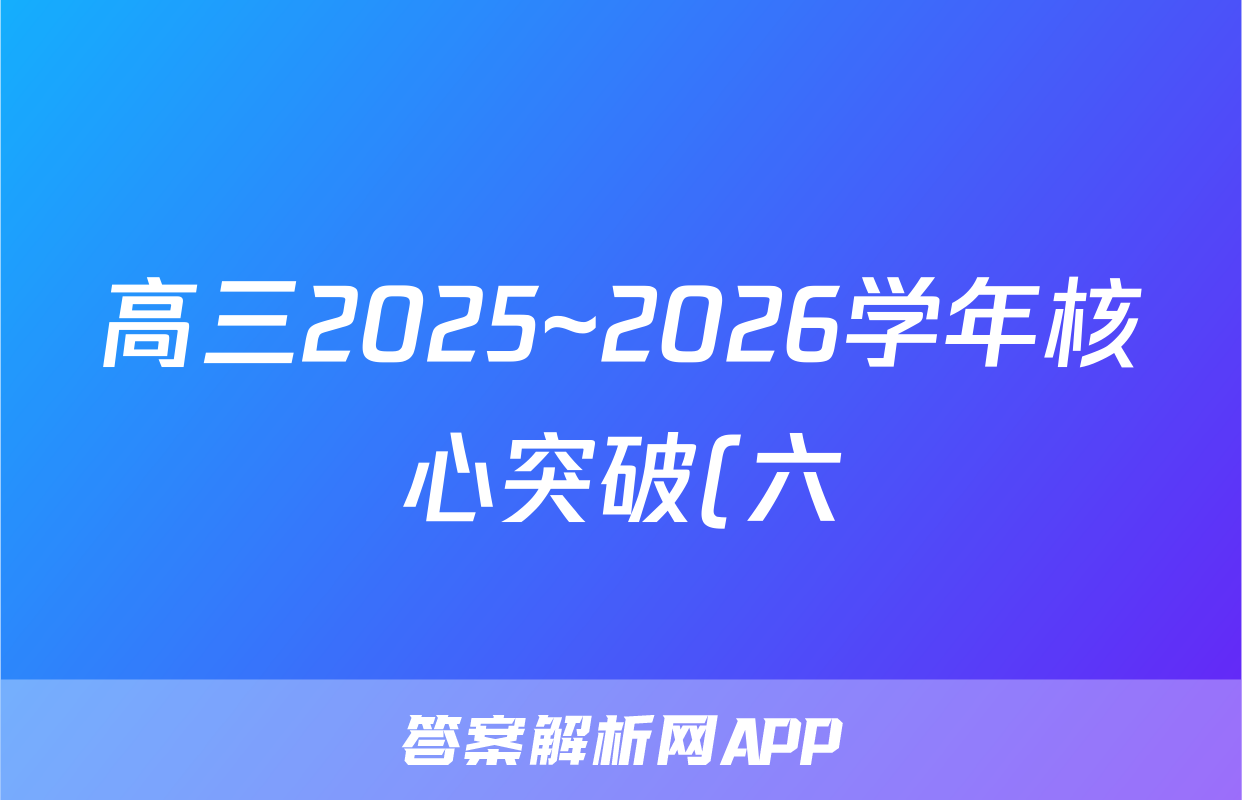
高三2025~2026学年核心突破(六)6英语答案正在持续更新,目前2025衡水名师卷答案网为大家整理了相关试题及答案,供大家查缺补漏,高效提升成绩。
本文从以下几个角度介绍。
-
1、2024—2024学年核心突破答案高三英语
2、2023-2024学年核心突破高三英语
3、2023-2024学年核心突破6英语
4、2023-2024核心突破英语答案
5、核心突破答案网址2023-2024高二英语
6、2024核心突破英语
7、2023-2024学年核心突破(二)英语答案
8、2024_2024学年核心突破英语
9、20242024学年核心突破英语高二
10、2023-2024学年核心突破英语
6英语答案) C. It was once considered inactive but now known to link ideas.30. Which outcome is associated with structured daydreaming in the text?A. Disengagement from reality.B. Decreased long-term memory.C. Strengthened stress and anxiety.D.Enhanced emotional management.31. Which real-life situation best matches the research findings on daydreaming?A. A student avoids all breaks to maintain focus.B. An artist schedules deliberate “mind-wandering time”.C. A teacher bans daydreaming in class to ensure discipline.D. A programmer works 12-hour shifts without mental pauses.DIn a quiet corner of Oxford University's Bodleian Library, a robotic arm flips through a 15th-centurymanuscript, its high-resolution cameras capturing every faded ink stroke. This is ARCHiVE (Automated RoboticCultural Heritage Inspection and Verification Engine), a f2.3 million project revolutionizing how fragile artifactsrepresents a model shift in cultural conservation.Traditional conservation methods often risk damaging delicate materials. ARCHiVE's robotic system,equipped with micro-sensors and Al algorithms, can detect cracks invisible to the human eye and predictstructural weaknesses before they worsen. “It's like having a doctor for ancient books,” explains Dr. Emily Carter,lead conservator. Since its 2022 launch, ARCHiVE has scanned over 8,000 items, from Egyptian papyri tomedieval maps, with 99.7% accuracy in damage assessment. Its non-invasive approach has reduced physicalhandling by 85%, significantly lowering the risk of accidental damage.The project's digital twin technology creates exact virtual copies, allowing global access to restrictedcollections. During the 2023 Cairo Museum flood, ARCHiVE's digital models enabled researchers to virtually"restore” water-damaged artifacts within hours. "We're not just saving objects," says Carter, "we're preservinghumanity's collective memory." This technology has also democratized access, with over 50,000 digital artifactsnow available to researchers and the public worldwide.However, some scholars argue that over-reliance on technology may distance researchers from hands-onby tech corporations. A 2024 survey revealed that 62% of conservators fear losing control over digitized culturalheritage.ARCHiVE's next phase involves 4D scanning, capturing how materials change over time. Pilot tests ondeveloping global standards for digital heritage, ensuring these technological marvels serve humanity rather thanforward-both physically and digitally."32. What is the main function of ARCHiVE's robotic system?A. Repairing damaged artifacts.B.Creating virtual museum tours.C. Identifying and forecasting damage.D. Selling digital copies of artifacts33.How did ARCHiVE help during the CairoMuseumflood?A. By raising emergency funds online.B. By training local conservation staff.C. By physically moving artifacts to safety.D. By providing digital models for restoration.34. What is Prof. Whitaker's main concern about ARCHiVE?A. Data ownership concerns.B. Loss of direct experience.C. High operating costs.D. Environmental impact.高三英语试题第5页(共8页)
C. It was once considered inactive but now known to link ideas.30. Which outcome is associated with structured daydreaming in the text?A. Disengagement from reality.B. Decreased long-term memory.C. Strengthened stress and anxiety.D.Enhanced emotional management.31. Which real-life situation best matches the research findings on daydreaming?A. A student avoids all breaks to maintain focus.B. An artist schedules deliberate “mind-wandering time”.C. A teacher bans daydreaming in class to ensure discipline.D. A programmer works 12-hour shifts without mental pauses.DIn a quiet corner of Oxford University's Bodleian Library, a robotic arm flips through a 15th-centurymanuscript, its high-resolution cameras capturing every faded ink stroke. This is ARCHiVE (Automated RoboticCultural Heritage Inspection and Verification Engine), a f2.3 million project revolutionizing how fragile artifactsrepresents a model shift in cultural conservation.Traditional conservation methods often risk damaging delicate materials. ARCHiVE's robotic system,equipped with micro-sensors and Al algorithms, can detect cracks invisible to the human eye and predictstructural weaknesses before they worsen. “It's like having a doctor for ancient books,” explains Dr. Emily Carter,lead conservator. Since its 2022 launch, ARCHiVE has scanned over 8,000 items, from Egyptian papyri tomedieval maps, with 99.7% accuracy in damage assessment. Its non-invasive approach has reduced physicalhandling by 85%, significantly lowering the risk of accidental damage.The project's digital twin technology creates exact virtual copies, allowing global access to restrictedcollections. During the 2023 Cairo Museum flood, ARCHiVE's digital models enabled researchers to virtually"restore” water-damaged artifacts within hours. "We're not just saving objects," says Carter, "we're preservinghumanity's collective memory." This technology has also democratized access, with over 50,000 digital artifactsnow available to researchers and the public worldwide.However, some scholars argue that over-reliance on technology may distance researchers from hands-onby tech corporations. A 2024 survey revealed that 62% of conservators fear losing control over digitized culturalheritage.ARCHiVE's next phase involves 4D scanning, capturing how materials change over time. Pilot tests ondeveloping global standards for digital heritage, ensuring these technological marvels serve humanity rather thanforward-both physically and digitally."32. What is the main function of ARCHiVE's robotic system?A. Repairing damaged artifacts.B.Creating virtual museum tours.C. Identifying and forecasting damage.D. Selling digital copies of artifacts33.How did ARCHiVE help during the CairoMuseumflood?A. By raising emergency funds online.B. By training local conservation staff.C. By physically moving artifacts to safety.D. By providing digital models for restoration.34. What is Prof. Whitaker's main concern about ARCHiVE?A. Data ownership concerns.B. Loss of direct experience.C. High operating costs.D. Environmental impact.高三英语试题第5页(共8页)
本文标签:

